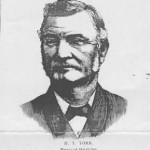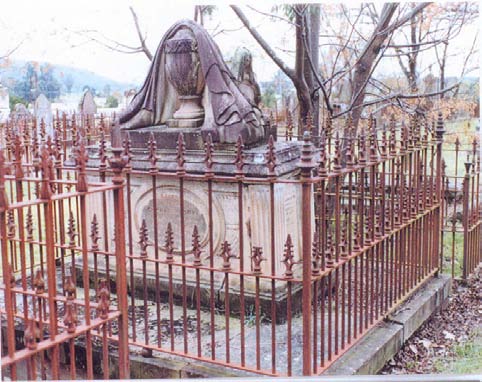A Glimpse Into Maria Charker’s Life
Maria Charker
(November 20th, 1811 – October 22nd, 1884.)
Maria was the third child, and the first daughter, born to William Charker and his partner Elizabeth Shackle. Maria was born at Prospect Hill, N.S.W. on November 20th , 1811. At the time of her birth she had two older brothers, Edward aged 2 and William just 1, as well as a half brother Daniel, aged 5. Daniel came out to the Colony with his convict mother on the Speke. At the time of both Maria’s and her brother William’s births, the family were living on Prospect Farm where William Charker was employed as the overseer. The following year he received a grant of land at Bringelly, but did not actually take up residence until 1814. It is here that the family was registered at the 1814 Muster.
It would seem that Maria’s father was a man of many talents, knew the value of investing in livestock, and was obviously well thought of by Government officials. In 1815 the Government was looking for a new overseer of its stock at the Cowpastures. The previous overseer had been James Blackman who, with his wife and 5 children, had come to the Colony as a free settler on the Canada in 1801. James held various minor official posts over subsequent years, including District Constable at Richmond for a total of fourteen years, interrupted by three years as Principal Overseer of Government Stock at the Cowpastures. Whether James resigned from his overseer’s position due to ill health, or whether he was just being his usual cantankerous self, is not known. However, the post was open and the Governor was anxious that it be filled quickly. William Charker and his family moved once more as he was asked to fill the vacancy.
At the age of almost 15 years, her father having now died, Maria married Charles York at St. Luke’s Church, Liverpool on August 21st, 1826. Charles, aged 21, was the son of Mary York who had property at South Creek next to the Charker’s, and who had witnessed William Charker’s last will and testament (she later re-married and became Mary Crooks). It is thought that Charles was actually born on the William Pitt when his mother was being transported to the Colony. In one statement, he described himself as being a “native of the Colony”. However, on his death certificate it states that he was “born at sea” and we definitely know, by the ship’s manifest, that his mother was accompanied by a child.
Soon after their marriage the following instructions from the Executive Council were issued:
Tickets of Occupation now in force, shall cease and determine, on the 1st Day of March 1827, and that Persons desirous of Grazing, will be required in future, to pay rent at the rate of Twenty Shillings Sterling per Annum for every One Hundred Acres further to quit the same on receiving Six months Notice.
That year (1827), Charles together with his elder brother, Henry, (who had joined the family in the colony as a convict transported on the Fame in 1817), made a joint application to rent, and later purchase, 1920 acres of the land which they were already occupying. This was some 12 miles south of the Shoalhaven River, called Mungattee Station. They then established another station, known as “Billilingra”, at Bredbo in the Monaro district, in approximately 1829.
In 1834 a Dr. John Lhotsky included a list of stations in “The Journey from Sydney to the Australia Alps”, and stated that the Yorks had 600 head of cattle grazing and 2000 sheep.
Pushing further westwards and across the Murrumbidgee, the York boys established a run at what is now known as Adaminaby. There was a need to find new lush pastures with waterholes, or rivers, nearby for the growing numbers of sheep and cattle. However, Maria and Charles seemed to spend most of their married life in and around the South Creek and Emu Plains areas. Charles seemed happy to leave most of the day to day running of his estates to relatives and employees although he doesn’t appear in the 1828 census, which suggests that he was up in the bush at that time. None of their children were born in the more remote areas and so it seems doubtful that Maria spent much, or maybe any, time at all on the more distant properties which her husband and their relatives were acquiring. Life for women would not have been easy in these more remote areas. There were few women in these regions until approximately the 1840s, and from all accounts, the squatters and their employees lived a lonely life with few home comforts. The licensing laws only gave grants for a period of 12 months at a time and could be revoked. This law made it difficult for settlers to build any lasting structure and make permanent homes at that time.
Maria and Charles had 8 children including twin boys.
The children are as follows:
William, born at South Creek, June 8 th, 1827
Charles and James, (twins) born at South Creek, December 17 th , 1829.
Harriet, born at Mulgoa, March 5 th, 1832.
Elizabeth, born at Mulgoa, March 27th , 1834.
Maria, born at Emu Plains, June 15 th , 1836.
Henry, born at Emu Plains, January 16 th, 1839.
Thomas, born at Emu Plains, July 28 th, 1841.
The eldest boy, William, became a wholesale butcher. He married Eliza Jane Ryan in 1849 and had 9 children. After Eliza’s death in 1870, William remarried to Grace Kirkpatrick in 1871 – they had no children.
The twins, Charles Jnr and James, were always close – maybe they were identical, we just do not know. Both married twice, their second marriages were to sisters. Charles married Emilia (known as Emma) Blackman in 1856, and James married Eliza Blackman also in 1856. James died in June 1880 and his heartbroken brother stood at his graveside and said “I’ll be with you in six months”. Charles Jnr actually died about 5 months later in the October.
Harriet married John Ryan in 1851, and had 5 children.
Elizabeth married Maurice Ryan in 1852, they had 6 children
Maria married George Dempsey in 1855, and had 13 children.
Henry, at the age of 18, managed his father’s station at Canonbar, Duck Creek. This was a pastoral district in the County of Wellington and close to what is now known as the town of Warren in N.S.W. Later he moved to Singleton, became the proprietor of an hotel, and later went on to become an Alderman and then Mayor of Singleton. He married Catherine Mortimer in 1857 at Emu Plains. They had 12 children.
Thomas married his cousin Annie York in 1862. She was his Uncle Henry’s daughter, and they had 11 children.
Maria was widowed before the age of 50, but never remarried although she herself lived for another 23 years. Charles and Maria’s property at Emu Plains remained their home all of their married lives, and stayed in the family at least until after Maria’s death in 1884. Both Maria and Charles are buried in the family vault at St. Paul’s cemetery, Emu Plains. Sadly, the original sandstone is wearing badly and it is now difficult to read the inscription.
The following article is from The Nepean Times, Saturday, October 25 th , 1884. This was a weekly newspaper covering the Emu Plains area. Maria York (née Chalker) died on Wednesday, October 22nd, 1884.
“Death of an Old Resident – One by one the old residents of this district appear to be dropping off, and it is our painful duty this week to record the death of one of the oldest residents of this district. Mrs. Charles York, who died at Emu Plains on Wednesday last after a long illness. The deceased lady was a native of the colony, and her children, grandchildren, and great grandchildren have been amongst some of the leading residents of the colony. Mrs. York was universally loved and respected, and although her husband, the late Charles York, died about 20 years ago she has ever since been one of the first in assisting to alleviate distress among her poorer neighbours. All her children with the exception of two, Mr. Henry York and Mrs. Morrice (sic) Ryan, have long since joined the great majority, but her grand children and great grand children are enormous. She lived to the ripe old age of 73, and her life was a most useful one. The funeral on Thursday was a large one and was attended by the principal residents of the district. She was interred in the family vault at Emu cemetery.”
Also in a copy of The Nepean Times was a report of the 50 minute sermon given by the incumbent of St. Paul’s, Emu Plains, on the Sunday following Maria’s death . It was described as “being listened to with rapt attention”. It included a reference to the general character of Mrs. York (Maria) and said how often she had sat in the now vacant seat just under the pulpit, and possibly how often she would have pondered over the day’s text. She was said to be a regular attendant. Sunday after Sunday she would be seen struggling to the church. “Oh, for more Mrs. Yorks in my parish”, he exclaimed!
Maria certainly made her mark on the world, didn’t she?
Compiled and written by Sylvia York.
Copyright © 2024. All Rights Reserved. | Design by: I.C. Enterprises


